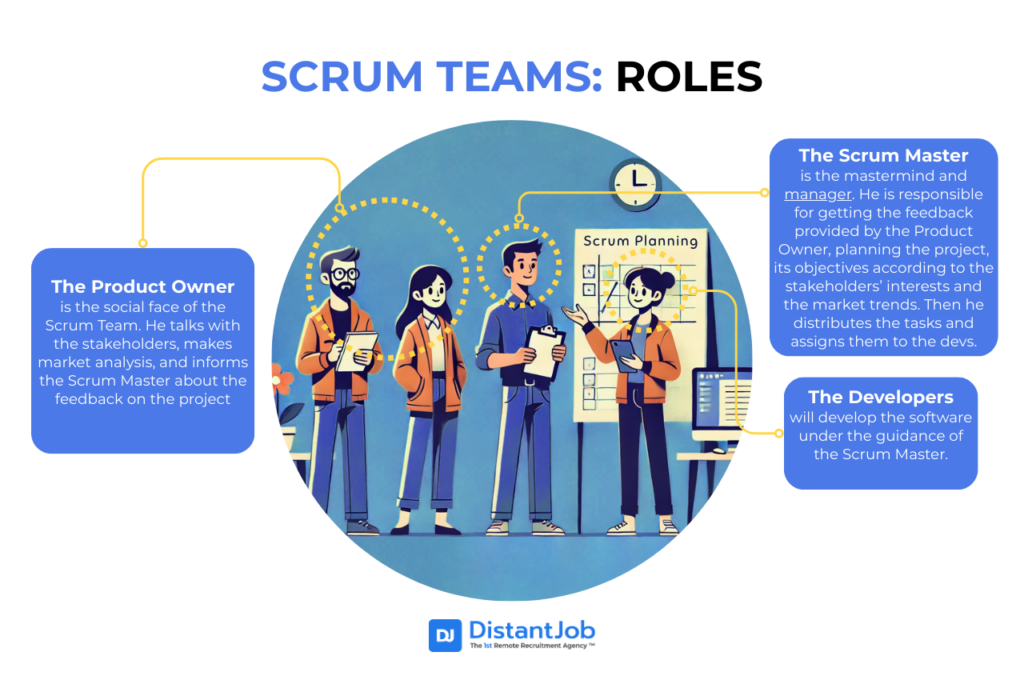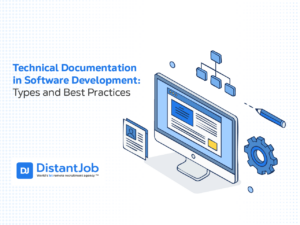To build an Agile team structure, you must start by deeply understanding Agile beyond common misconceptions. You are Agile or not in the same way you are healthy or not. If you eat a healthy salad every Sunday and eat fast food garbage for the rest of the week, you’re not healthy. The same thing goes for being Agile: If you just bring some terms and processes, likely from Scrum, but do not incorporate its Values and Principles into your business, you will not be Agile. And this is where many businesses fail; they adopt tons of Agile practices without understanding what this is about.
Genuine agility is about embedding Agile values—collaboration, adaptability, continuous improvement, and customer-centricity—into the company’s culture.
For those companies that are really Agile, they couldn’t be more successful; for those who want to label themselves as Agile without understanding its core, they keep asking themselves what is going wrong. So, let’s start by defining what Agile is.
What is Agile?
Agile is a philosophy of setting goals, driving change, executing tasks, making an analysis of what has been done, and changing course to the next goal. Agile prioritizes connection with customers and employees, having an MVP (Minimum Viable Product, finished, not perfect) and changing plans as fast (or as Agile) as possible.
It’s different from the traditional worldview of management, where plans had to be followed at any cost, processes were sacred and untouchable, and product value was defined by the view of a big corpo and not the market.
In short, Agile is about the management being flexible and adaptable. All Agile frameworks and good practices come from that view. If you don’t understand this raison d’être, no Agile team structure will help you.
Dave Thomas, one of the Agile Manifesto signers, had a whole speech about Agile at the GoTo d practices related to Agile. They wrote the Agile Practice Guide (a top-tier guide on Agile).
What Is an Agile Team Structure?
Agile team structure is an approach to organizing teams that is designed to achieve the benefits of agile-based development (faster time to value, flexibility, increased user involvement). Agile teams are comprised of small autonomous teams that can operate flexibly while remaining aligned with the overall company. This structure focuses on collaboration, transparency, and adaptability, over controls and documentation.
Agile teams are usually small (5-9 people) and include all skills required to deliver a feature or working product. Additional specialized developers are added to the project team to maximize sharing and collaboration.
Core Roles in an Agile Team
The core roles in an agile team vary slightly depending on the specific framework being used, but three fundamental roles appear across most agile methodologies: product owner, scrum master and developers.

1. Product Owner
The product owner is the social face of the Scrum Team. He talks with the stakeholders, makes market analysis, and informs the Scrum Master about the feedback on the project.
Responsible for managing the backlog of work, writing user stories and priority orders, and making decisions on scope and requirements, which requires strong IT and business skills. They have a strong understanding of the customer and the organization’s strategy for the product/solution being produced. Responsible for ensuring that the development is delivering the right product.
2. Scrum Master
The Scrum Master is the mastermind and manager. He is responsible for getting the feedback provided by the Product Owner, planning the project, its objectives according to the stakeholders’ interests, and the market trends. Then he distributes the tasks and assigns them to the developers.
He is also responsible for teaching agile principles, facilitating meetings, and protecting the team from disruptions. Scrum leaders are more focused on process improvement and less on people management. Depending on the specific agile methodology, other names for this role include Agile Coach and Team Lead.
3. Development team members
The developers are the ones building the software product under the guidance of the Scrum Master. They are responsible for sizing the work, solution design, development, testing, and quality, so you’ll have testers, designers, and analysts among the devs. The team works as a self-managed team and determines how work will be delivered.
How to Build an Agile Team Structure
To become Agile effectively in your software development team structure, you must understand that Agile is a philosophy and a way to think and interact. Only then, you may adopt an Agile framework. Here is how you become Agile effectively:
1. Understand and adopt values and principles from the Agile Manifesto
This is the most important step by far. If you implement an Agile framework without understanding the values and principles, everything will go FUBAR. Yes, being Agile will allow your software development team structure to develop software with ease… only if you are committed to:
- Focus on individuals and interactions over nice tools or operational processes;
- Have a program that works as intended rather than writing a gargantuan and extensive documentation – unless you love making your devs waste time;
- Collaborate with the stakeholders rather than doing only what is written in a contract;
- Respond to change rather than getting frustrated because you designed a perfect, careful plan, and now no one will follow it anymore.
I can’t emphasize it enough. This is the essential requirement for being Agile. Period.
2. Ask constant questions about the job and look for new ways to work
Since you are willing to answer to change, you are willing to change the workflow. Maybe even going remote. Why not?
There is a book that I love, studied in many MBA courses, called The Goal, by Eliyahu Goldratt.
The Goal is a story about a factory manager obsessed with making people, causing bottlenecks, and making the factory produce less and less by day. Finally, he meets a mentor who shows him some process management techniques, and they change the factory workflow. The factory unleashes its hidden potential, and it produces as never before.
The same can happen with your software development team structure and even to your company. Are you up to the challenge?
3. Prioritize collaboration and interaction between people
Teamwork, feedback, and improvement are more important than your expensive hardware. What scares most AI companies the most about DeepSeek is that their team had no access to certain GPUs crucial to AI development, and yet they developed an AI as good as the best in the US.
While many people seem to be impressed with the feat — and, in fact, it holds merit — I bet that they know how to collaborate well with each other. They are young programmers in their 20s, without the stubbornness of “I have been working like this for decades and won’t change”.
Don’t forget to build trust and effective communication.
4. Focus on delivering value incrementally
Incremental delivery focuses on delivering a series of smaller pieces of the project over time, instead of delivering the entire project at once. It’s important to celebrate the first values, that is, the first part of the project done well. In that way, the software development team can track the progress more easily.
5. Be open and ready to respond to the changes
The Market changes and the Stakeholders also change their minds often. You have two options. Tell them “It’s not in the contract,” and they will change for a company that changes things as they wish. Or you can change the project and keep track of the market’s needs and your stakeholders as well. It’s up to you.
You will notice I am not giving practical examples and good practices here. There is no quick-and-dirty guide: Each team needs to build its way towards Agile principles and values, using an Agile framework as a starting point. As soon as you choose an Agile framework for your software development team, we can talk about practical examples.
Also, you must acknowledge that Agile works not only on projects but throughout the company as a whole. It will be much easier for your team if you adhere to Agile philosophy as a business and not only as a structure for your software development team.
Solving the Biggest Misconceptions About Agile
Digital’s 17th State of Agile Report says that, in 2022, the companies’ satisfaction with Agile was about 72% and it dropped to 59% in 2023 — still a good margin, but why had it dropped?
The reason, says the report, “their company still has many legacy systems requiring a mixed approach”. In other words, you must implement Agile principles and values correctly to extract its benefits; you have to understand the difference between Agile and its frameworks, or you are doomed to fail. Here are the mistakes you must avoid at all costs.
1. Agile and Scrum are not the same
Agile is a philosophy, guided by principles and values, breaking old and traditional paradigms of management and software development.
Scrum is a framework, the most common and the oldest Agile framework. But there are others, like: Disciplined Agile (a mix between Lean and Scrum), Kanban, Extreme Programming (XP) etc.
2. Traditional approaches are compatible with Agile principles
While I am a big defender of changing traditional management, Agile is 100% compatible. Agile can even spark the needed change for a software development team or a company to restructure itself into a better version of itself, but it doesn’t necessarily need to change its traditional ways.
However, you will benefit from Agile the most when you change your software development team structure to accommodate Agile principles and values. Do you remember when I showed you Digital’s 17th State of Agile Report and showed you the reason why some companies are dissatisfied using Agile? They weren’t allowing Agile to change their company culture!
3. Agile allows change
It does. It lives by it. It’s not a cult. The whole point of Agile is to respond to changes as quickly as possible, therefore the name. The thing is: which changes does your software development team structure have to respond? Stakeholders? Unexpected bugs? If the framework you had chosen doesn’t have a way to respond to the changes, you are free to change the framework to suit your needs. Frameworks are toolboxes, not Gospels.
4. Don’t just pay lip service
Talking about Scrum meetings and using Agile terms won’t magically turn your project into an Agile project. Adopting the names and rituals without understanding the principles and values of Agile will turn your company into chaos.
For example, let’s say you implement Scrum without understanding Agile principles and values. That will turn the Product Manager and the Scrum Master into “Boss 1” and “Boss 2”. You will make them compete for the control of your software development team structure. It will be a terrible scenario where the whole team is paralyzed due to conflict.
Conclusion
Agile enables a software development team to deliver software on time to market. It facilitates communication between the team and stakeholders. Agile also identifies bottlenecks and addresses them quickly and swiftly. Finally, it adapts to any circumstances as if your company were water.
Take note that Agile is not a magical solution to stubbornness. You may have noticed while reading about Scrum that an Agile Team Structure is very flexible and adaptable, ready to change course at any moment. However, if the company’s decision-makers do not desire changes in the project, an Agile Team Structure can’t do much.
I already mentioned Digital’s 17th State of Agile Report. Agile teams can’t deliver value if the company focuses on processes instead of people, or if the executives want to stick to a failed plan. Ultimately, building an Agile team structure isn’t about checking off methodologies but about cultivating a deeply adaptive, collaborative, and responsive organizational culture.
Agile teams can deliver value if you are ready to take the Agile step alongside your team. It pays off, so why don’t you try it now?
Now, maybe you need to a hire a dev, a scrum master or a product owner to get ready and start it as soon as possible. Book a call with us and we will find you the best remote hire in the world!
FAQs on Agile Team Structure
The optimal size of an agile team is typically 5-9 people, following the “two pizza rule”: if you need more than two pizzas to feed the team, it’s probably too large. Smaller teams (3-5) can move faster but may lack necessary skills, while larger teams (10+) struggle with communication overhead and coordination complexity.
Full-time dedicated team members. Having team members working part-time on other activities leads to inefficiencies due to context switching, reduces collaboration, and makes it harder to commit and deliver sprints on time. Part-time allocation is not a good idea.
Remote agile teams can be successful with the right tools and practices. Online daily standups, digital collaboration boards, and asynchronous communication tools help maintain transparency and coordination.





